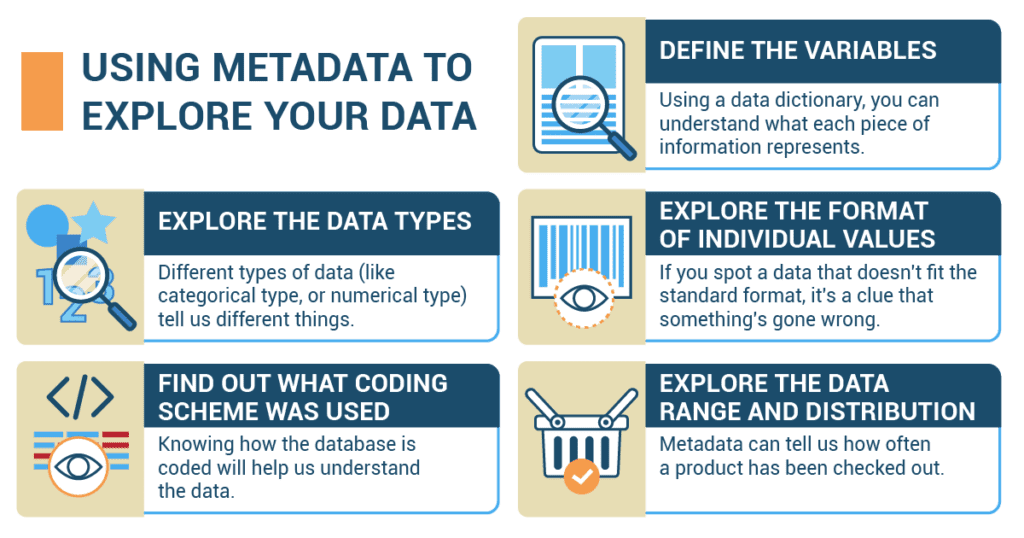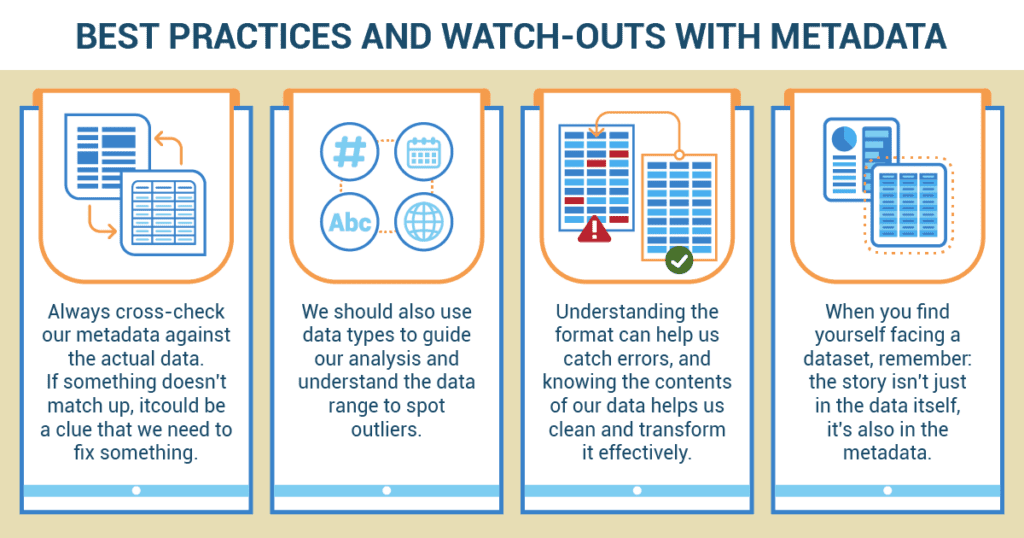I want you to imagine for a moment that you’re in an enormous, sprawling library. Picture the rows and rows of books, each one filled with stories, information, and ideas, each one a world unto itself. But there’s one catch: there are no titles, no authors, no table of contents, and no indices in these books. Now, if I were to ask you to find a book on a specific topic – say, the history of Renaissance art – where would you begin? How much time would you have to spend flipping through each book, hunting for the exact information you need?
Well, in many ways, the digital world we’re living in is like that vast library. But thankfully, we have something that makes navigating this world of information more manageable. And that something is metadata.
So, you might be wondering, “What is metadata?” Essentially, metadata is data about data. It’s the titles, authors, and table of contents for our digital library. It’s the details that tell us what a file is, when it was created, who created it, what’s in it, and so much more. It’s the secret ingredient that helps us make sense of the vast digital universe we navigate every day, even if we’re not always aware of it.
Every time you Google a question and find an answer, every time you search for a file on your computer, every time you sort your music library by artist, album, or year, you’re using metadata. In fact, if you’ve ever cursed your computer for not being able to find a document you know you saved somewhere, you’ve encountered the frustration of a world without sufficient metadata.
Over the next few minutes, I’ll guide you on a journey to understand the significance of metadata how it allows us to explore the vast depths of information at our fingertips, its role in our everyday lives, and how we can leverage it effectively to enhance our understanding of the world around us. So buckle up, and let’s dive into the unseen, unsung hero of our digital universe: metadata.
Why Understanding Your Data is Important
Let’s say you’re a corporate manager aiming to boost employee satisfaction. You conduct an extensive employee survey to gather data on workplace concerns. But to make sense of this data, you need metadata – details like departments, roles, tenure, and participation in company activities. This metadata provides context, helping you pinpoint key areas for improvement. By correlating job roles with satisfaction levels and analyzing participation history, you can tailor strategies to address specific needs, enhance employee morale, and create a more satisfying work environment.
This is just like how in data analysis.
- Understanding the contents helps in selecting relevant features or variables for analysis. You can identify variables of interest and their potential relationships, enabling targeted investigations like the relationship between years of service and concerns.
- Understanding the contents (e.g., data types) is important for selecting appropriate analysis techniques and performing data manipulations accurately.
- Understanding the contents helps you explore the patterns, relationships, and distributions within the data.
- Understanding the contents aids in the interpretation of analysis results. For instance, let’s say the company cafeteria wants to introduce new meals, and they conduct a taste test. If they report that a meal had an average rating of 8, it would make a big difference if we knew whether the ratings were out of 10 or 100!
Using Metadata to Explore Your Data

- Define the Variables: Use a data dictionary to get a description of each variable, including what they represent and their units of measurement. For instance, knowing that ‘checkouts’ means the number of times a file has been “borrowed” can help you see which files are most needed. These descriptions can provide insights into what each variable represents, its purpose, and its expected data type.
- Here are some common ways in which metadata defines variables:
- Variable Name: Metadata often includes the name or label assigned to a variable, which serves as its identifier in the dataset or system.
- Data Type: Metadata specifies the data type of a variable, such as numeric, categorical, text, date, or boolean. This information helps us understand the nature of the values the variable can hold.
- Description: Metadata provides a description or brief explanation of the variable, highlighting its purpose, meaning, or significance. This description aids in understanding the variable’s role in the dataset or system.
- Units of Measurement: For variables that represent physical quantities (e.g., length, weight, time), metadata may include the units of measurement applied to the variable values. This information ensures proper interpretation and comparison of the data.
- Valid Value Range: Metadata may define the valid range or acceptable values for a variable. It sets boundaries or constraints on what values are considered valid or meaningful. This helps identify data quality issues or anomalies.
- Relationships or Dependencies: Metadata may describe relationships or dependencies between variables. It can specify if a variable is linked to other variables through hierarchical, temporal, or other types of relationships.
- Source or Origin: Metadata may indicate the source or origin of a variable, such as the data collection instrument, survey, database, or system from which the variable is obtained. This information aids in tracking the data lineage and assessing data quality.
- Contextual Information: Metadata may provide additional contextual information about a variable, such as its intended use, historical background, legal or ethical considerations, or any specific assumptions or limitations associated with the variable.
- Here are some common ways in which metadata defines variables:
- Explore the Data Types: Different types of data tell us different things. Use metadata to get information on the data types (integer, string, float, boolean, etc.) in your dataset. A book’s genre (like mystery, fantasy, or biography) is a categorical type of data, while the number of times it’s been checked out is a numerical type.
- Explore the Format of Individual Values: Metadata may specify the length or format of fields, particularly for string variables. For example, A book’s ISBN number has a specific format. If you spot an ISBN number that doesn’t fit this format, it’s a clue that something’s gone wrong.
- Find out what coding scheme was used for categorical data and missing data. A data coding scheme, also known as a codebook or coding system, is a set of rules or guidelines used to assign codes to represent specific categories or values for data elements. It provides a standardized method for encoding or classifying data, making it easier to analyze and interpret information consistently. This information is valuable in understanding any limitations or restrictions on the data, such as character limits or specific formatting requirements. In our library database, genres might be coded as numbers (like 1 for Mystery, 2 for Fantasy). Knowing this helps us understand the data.
- Explore the Data Range and Distribution: It describes the range of values that variables can take and provides insights into the distribution or spread of those values. Metadata can tell us how often a book has been checked out. If one book was checked out 500 times last month while most others were only checked out once or twice, we might have a super popular book on our hands!
Best Practices and Watch-outs with Metadata

- Validate the metadata by cross-checking it against the actual data. Ensure that the data values, formats, and patterns align with the information provided in the metadata.
- Use the data types to help you determine the kinds of operations and analysis to perform on each column.
- Use the data range to identify and correct outliers. Understanding the context helps to distinguish between outliers that are data errors and those that represent genuine high or low values.
- Use the formatting standards to identify and correct formatting errors. If metadata indicates a column of dates should follow a particular format, and you find dates that do not match this format, this indicates an error that should be corrected.
- Use your understanding of the data contents to guide data cleaning and transformation. Knowledge about the contents can guide your decisions about how to handle missing data and whether certain variables need to be transformed (like applying a logarithm to highly skewed data)
Enhancing Toy Manufacturing Efficiency through Metadata Analysis
In the dynamic world of toy manufacturing, precision and innovation are essential for staying competitive. One prominent toy company, “PlaySolutions,” embarked on a journey to optimize its manufacturing processes by harnessing the power of metadata analysis. By delving into the metadata associated with its toy production data, PlaySolutions sought to unlock insights that would drive efficiency, reduce costs, and ensure top-quality products.
PlaySolutions operated multiple production lines, each responsible for manufacturing a wide range of toys. Over time, the company amassed a vast amount of production data, including material usage, machine performance, and defect rates. However, this data existed in silos, making it difficult to gain a comprehensive understanding of the manufacturing process. PlaySolutions needed a solution that would enable them to uncover hidden patterns and correlations within this data to streamline their operations. Recognizing the potential of metadata, PlaySolutions’ data analytics team focused on enriching their production data with context.
They collected metadata such as:
- Toy Specifications: Metadata detailing the specific type of toy, design specifications, and intended age group provided a comprehensive view of the manufacturing requirements for each product.
- Machine Parameters: Metadata about machine settings, maintenance schedules, and historical performance enabled a deeper analysis of how machine variations affected production output and quality.
- Supplier Information: Metadata on the source of raw materials, supplier performance, and lead times shed light on the impact of material quality and availability on the manufacturing process.
- Production Shifts: Metadata related to production shifts, workforce allocation, and employee expertise allowed PlaySolutions to assess the impact of staffing patterns on production efficiency.
Results and Impact:
By leveraging metadata analysis, PlaySolutions achieved remarkable improvements in its toy manufacturing operations:
- Optimized Production Planning: Analyzing toy specifications and historical demand data, PlaySolutions gained insights into the most efficient production scheduling. This reduced overproduction and minimized inventory costs.
- Reduced Defect Rates: The correlation between machine parameters and defect rates was uncovered through metadata analysis. This insight allowed PlaySolutions to fine-tune machine settings, resulting in a 15% reduction in defect rates.
- Supplier Collaboration: Metadata analysis revealed patterns in material quality based on supplier data. Armed with this information, PlaySolutions engaged in constructive dialogues with suppliers to improve material quality, ensuring consistent toy quality.
- Enhanced Workforce Management: Metadata insights into workforce allocation across different production shifts led to optimized staffing patterns, reducing overtime costs and improving production efficiency by 10%.
Conclusion:
PlaySolutions’ experience underscores the transformative potential of metadata analysis in the corporate world. By exploring the metadata associated with toy manufacturing data, the company achieved unprecedented operational improvements. The integration of metadata into their analysis provided a deeper understanding of production processes, enabling smarter decisions and driving efficiency gains. This case study serves as a testament to the power of metadata analysis in uncovering hidden opportunities and optimizing operations within the dynamic landscape of toy manufacturing.